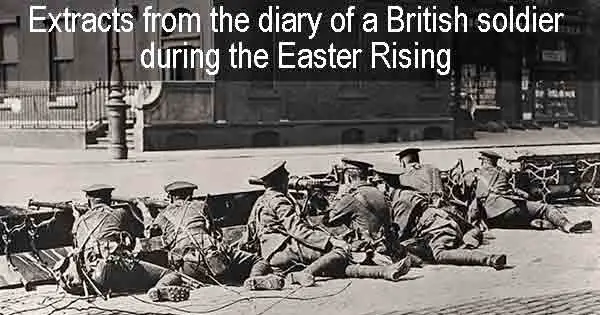Extracts from the diary of a British soldier during the 1916 Easter Rising give a brutally honest and harrowing insight into the events of that fateful week from the British point of view.
It is also reveals much about the strength of character of the Rising leaders who each stood proud as they were about to be executed. They were willing to die as they had such a firm belief that the Rising would become an event of vital historical importance. Patrick Pearse whistled as he walked to face the firing squad.
The diary was written by a British soldier, Sgt Maj Samuel Lomas, who was sent to Ireland after the Rising had begun.
Lomas records his activities during the week of the Rising and up until the executions of three of the leaders, Tom Clarke, Patrick Pearse and Thomas MacDonagh.
The 1916 diaries
The diary is included in the book ‘The 1916 diaries’ which was collated by author Mick O’Farrell.
The extract is taken from the Irish Times. It includes corrections made by O’Farrell for mistakes in the details of Lomas’ diary, including the names of the Rising leaders.
Extracts from Samuel Lomas’ account of Easter 1916
APRIL 24th
8.30pm Watford. Received orders to prepare for a sudden move.
APRIL 25th
3.20pm Boarded the Royal Mail steamer Ulster for Kingstown.
APRIL 27th
Noon Marched out from the Royal Hospital en route for Dublin Castle. All along the road, constant sniping was going on but the Royal Irish, by keeping up a constant fire in the direction of the snipers, prevented them from concentrating their fire on the column. We arrived at Dublin Castle without any casualties.
6pm ‘D’ Coy were ordered to proceed along Cappel Street, Parnell Street to consolidate the position held by the Royal Irish. We moved out and on crossing the bridge over the river from Parliament Street, we came under heavy fire from the Sein Feinners. We proceeded up Cappel Street and on entering Parnell Street, at every cross street we were subjected to rifle fire from the enemy. On arrival at Moore Street, I was instructed to make a barricade right across the street.
APRIL 28th
10am The men were allowed to rest in the sun when not on duty, taking care to have cover from the snipers in the locality.
Noon One 18-pounder arrived and laid facing down Moore Street in the direction of the G.P.O. Four shells were fired which caused the rebels to quake, as for some considerable time, the rifle fire was silent, with the exception of a few snipers. The artillery proved most useful, & were in my opinion mainly the cause of the surrender of the rebels.
7pm Trouble by a man several times coming to the barricades, he being full of beer.
APRIL 29th
9am Received instructions to prepare for storming parties of 20 men and an officer, and to provide ourselves with tools of any description to break down the doors etc. To search the houses through to Henry Street and to make a breach when necessary in the walls.
12.30pm All ready and the assault commenced. My party were allotted to an alley with houses either side. My weapon was a bar 5’6” long 1” strength with a lever end – a beautiful tool for the purpose. I struck at one door such a smack and knocked the door complete for some 5 yards into the house, breaking hinges and lock at the same time. Sweating like the devil! (Rather with fear, excitement or work) It is surprising how the lust to destroy comes over you.
2pm Orders are passed for us to stand by as a white flag was approaching the end of Moore Street. This was found to be from Sean O’Connelly [James Connolly] asking for terms of surrender. Instructions were sent back up the street for O’Connelly to come down and interview the General in command of our troops. This was done, O’Connelly being carried down on a stretcher, as he was wounded in the leg. Whilst standing by, we came across the dead body of O’Reilly [the O’Rahilly], the acting adjutant.
MAY 2nd
9pm I was warned to provide a party of 48 men and 4 sergeants for a special duty parade at 3am the following morning. I was told as a special favour I had been allowed to go as one of the party as senior NCO.
MAY 3rd
We paraded at the time appointed, marched to Kilmainham Jail. At 3.45 the first rebel MacDonoghue [Thomas MacDonagh] was marched in blindfolded, and the firing party placed 10 paces distant. Death was instantaneous. The second, P.H. Pierce [Pádraig Pearse] whistled as he came out of the cell (after taking a sad farewell of his wife.) [Pearse wasn’t married, and was visited only by a Capuchin priest, Fr Aloysius.] The same applied to him. The third, J.H. Clarke [Tom Clarke], an old man, was not quite so fortunate, requiring a bullet from the officer to complete the ghastly business (it was sad to think that these three brave men who met their death so bravely should be fighting for a cause which proved so useless and had been the means of so much bloodshed).
5am This business being over, I was able to return to bed for two hours and excused duty until noon.
Samuel Lomas was a serving with the Territorial Force, which was the name of the volunteer reserve at the time.
By the time he was sent to Ireland he had served for nine years with the Second Volunteer Brigade of the Sherwood Foresters. He was awarded the South Africa medal for his service in the Boer War.
After leaving Ireland, he was sent to France during the First World War. He died in 1917 and has no known grave. He is commemorated on the Thiepval Memorial to the Missing of the Somme.
